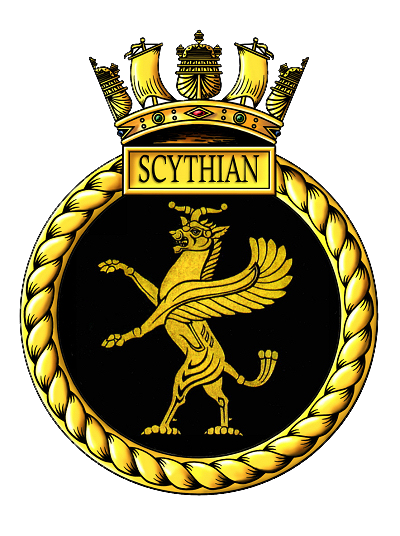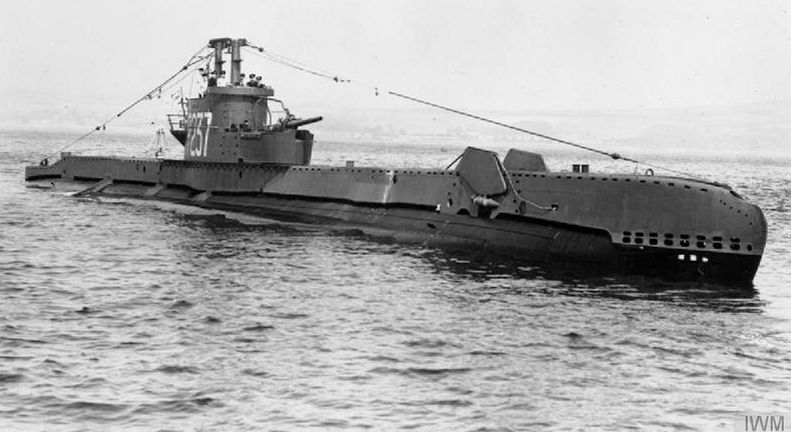S-Class Submarine

Battle Honours
Atlantic 1944
Malaya 1945
Specifications
Builder: Cammell Laird Shipyard, Birkenhead, United Kingdom
Displacement: 814 tons
Length: 217 ft
Beam: 23 ft 8 in
Draught: 11 ft
Propulsion: 2 × 950 bhp (708 kW) diesel engines, 2 × 650 hp (485 kW) electric motors driving two propellers
Speed: 14.75 knots (16.97 mph; 27.32 km/h) surfaced. 9 knots (10 mph; 17 km/h) submerged
Range: 7,500 Nautical miles surfaced (8,600 mi; 13,900 km) at 10 knots (12 mph; 19 km/h) 120 Nautical miles submerged ( 140 mi; 220 km) at 3 knots (3.5 mph; 5.6 km/h)
Armament: 6 × bow & 1 stern 21 in (533 mm) torpedo tubes – carried 13 torpedoes or 12 mines; 1 × three-inch (76 mm) gun (QF 4-inch deck gun; 1 × 20 mm Oerlikon AA gun;; 3 × .303 calibre machine guns
Crew complement: 48
Commanding Officers
Lt. Arthur George Chandler, RNR 15 Dec 1943
Lt. Guy Stewart Chetwode Clarabut, DSO, RN 17 Apr 1944 - 13 Nov 1945
Lt. Stoop, D.S.C., R.N. 1950
Lt. R.J. Hay Apr 1951
Lt. Cdr A.H.E. Cook 01 Feb 1953
Lt. D.H. Lorimer21 Jul 1958
Related items
None
Reminiscences
None
Gallery
None
H.M. S/M SCYTHIAN
Read aloud

Image copyright IWM (FL 18839)
History
She was ordered from Scotts Shipbuilding & Engineering Co., Greenock, Scotland, on July 12th 1941, one of the batch three boats ordered as part of the third group of S class submarines for the Royal Navy. Her keel was laid down on February 21st 1943. She was launched on April 14th 1944.
She commissioned at Greenock as H.M. Submarine SCYTHIAN on August 11th 1944 under the command of Lieutenant C. P. Thode, RNZNVR. She was the only RN vessel to bear this name. She departed her builder’s yard for Holy Loch on August 15th to begin a period of trials and training in the Clyde area, arrived there on the same day. Here she joined the 3rd Submarine Flotilla, attached to the depot ship HMS FORTH, which was responsible for submarines operating in the North Sea and Bay of Biscay and also the supervising of the trials and working up of all new construction submarines.
While at Holy Loch she conducted Torpedo, Gunnery, Bombardment, D/F and RDF exercises and performed simulated day and night attacks, both submerged and surface actions. She also performed trials at the torpedo firing range at Arrochar. Local vessels acted as targets; the Armed Yacht HMS CUTTY SARK was her target for a night attack exercises on August 31st and a day attack and RDF exercises on September 3rd.
SCYTHIAN in company with H.M. Submarine SEA SCOUT sailed on September 5th for Scapa Flow escorted by CUTTY SARK, arriving on the 7th to conduct attack and A/S exercises. She exercised with the destroyer HMS CAMBRIAN on the 8th. On the 10th she conducted attack exercises at Scapa Flow during which H.M. Submarine TRUSTY acted as a target. She conducted A/S exercises with destroyers HMS MILNE and HMCS ALGONQUIN. On the 16th she exercised with the Fleet Carrier HMS INDEFATIGABLE and her escorts destroyers HMS CAPRICE and HMS OFFA with the carrier as the target. She continued A/S exercises with CAPRICE the following day and HMS ZAMBESI on the 19th and 20th. She completed her final day of A/S exercises with CAMBRIAN on September 21st.
SCYTHIAN departed Scapa Flow to return to Holy Loch on September 24th in company with H.M. Submarines SEA SCOUT and SCEPTRE, escorted by the destroyer HMS SHIKARI. She was to spend a further six weeks in training and exercising off Larne to bring her to operational readiness.
1st war patrol: H.M. Submarine SCYTHIAN departed Holy Loch for her 1st war patrol on November 5th 1944, this was a short work-up patrol in the North Sea which ended on her arrival at Lerwick on November 19th. She arrived back at Holy Loch on the 23rd and was docked in Admiralty Floating Dock No 17 on the 27th; she was undocked on December 2nd.
Allocated to the East Indies Fleet
H.M. S/M SCYTHIAN sailed from Holy Loch for passage to Gibraltar on December 12th on the first leg of voyage to the Far East to join the East Indies Fleet. She took passage with convoy OS.98 / KMS.72 , arriving at Gibraltar on the 20th. She sailed for Malta on the 26th, arriving on the 30th.
On January 3rd 1945 SCYTHIAN sailed for Port Said, arriving on the 7th. She remained there until the 16th when she entered the Suez Canal on passage to Aaden. After an overnight stop at Aden on the 21st she arrived at Trincomalee on February 3rd. She was now part of the 2nd Submarine flotilla attached to the Submarine Depot Ship WOLFE.On January 3rd 1945 SCYTHIAN sailed for Port Said, arriving on the 7th. She remained there until the 16th when she entered the Suez Canal on passage to Aaden. After an overnight stop at Aden on the 21st she arrived at Trincomalee on February 3rd. She was now part of the 2nd Submarine flotilla attached to the Submarine Depot Ship WOLFE.
2nd war patrol: She departed Trincomalee on February 24th for her 2nd war patrol (1st in the Far East) to patrol off the Mergui Archipelago. During the period 3 0 5 March she was tasked to perform air/sea rescue duties. On March 8th, between Rangoon and the Mergui Archipelago, she sank three sailing vessels with gunfire off the coast of Burma. She was again tasked with air/sea rescue duties covering march 10- 12th. On March 14th, between Rangoon and the Mergui Archipelago, she sank a further three sailing vessels with gunfire. This was followed by two more sailing vessels sunk with gunfire and scuttling charges on the 15th. She arrived back at Trincomalee on March 29th.
3rd war patrol: After storing, fuelling and self-maintenance SCYTHIAN sailed for her 3rd war patrol (2nd in the Far East) on April 6th, this time to patrol the northern part of the Malacca Strait. Eight days later, on the `14th she received new orders to leave her patrol area and return to Trincomalee. She arrived back alongside HMS WOLFE on the 19th.
4th war patrol: Her next patrol was to cover the sea borne assault on Rangoon codenamed Operation DRACULA. Her next patrol was to cover the sea borne assault on Rangoon codenamed Operation DRACULA. Foor this operation three S Class boats were employed; SUBTLE, and STATESMAN sailed on the 24th followed by SCYTHIAN on the 25th to patrol in the Malacca Strait off the One Fathom Bank and the Aroa Islands to prevent interference by the heavy Japanese cruisers ASHIGARA and HAGURO based at Singapore, and if repaired by the TAKAO and MYOKO. Their orders were principally for reconnaissance, reporting any sighting of these ships and not to attack without new orders. Operation DRACULA commenced on May 2nd and was concluded by the 5th. The three submarines received new orders on the 9th they were now to attack the enemy first and then report. However, both STATESMAN and Scythian had found it necessary, on 1st and 5th May, to sink small craft that had seen them so as to prevent the compromising of their patrol positions.
At 2230 on the 9th the submarines STATESMAN and SUBTLE, in the Malacca Straits, both reported sighting one Japanese cruiser of the NACHI class, with single destroyer escort proceeding north westward. At 1840 on May11th SCYTHIAN engaged a Japanese coaster of about 100 tons [Akiyama Maru no. 10?], and two landing craft in a surface gun action sinking all three after a 30-minute engagement during which she received minor damage. Just before midnight on the `8 she sank a sailing vessel with gunfire in the Strait of Malacca. This was followed in the early hours of the 19th by a second sailing vessel, a Chinese twakow, sunk at 0556. She ended her 4th war patrol at Trincomalee on May 24th.
She now underwent a period of maintenance; during this period her battery was replaced and the boat was fumigated as she was infested with rats. She sailed for Combo on June 26th for the Battery change to be carried out, arriving there on the 28th. She remained at Colombo until July 23rd when she sailed for Trincomalee, arriving back at her depot ship on the 25th. She di not undertake another war patrol before the Japanese surrender was announced on August 16th.
Return to the UK
By the second week of September the decision had been taken to send SCYTHIAN back to the UK; she departed Trincomalee on September 16th, calling at Colombo on the 18th and siling for the Suez Canal the same day. She arrived at Port Suez on October 2nd, arrived Port Said on the 3rd and sailed for Alexandria the same day. She arrived at Alexandria on the 4th and spent the next 7 days in port.
SCYTHIAN sailed for Portsmouth on October 12th, calling at Gibraltar on the 19th and arriving home on October 24th 1945.On November 13th she was placed in reserve at Fort Blockhouse, Portsmouth.
Post War history
After the war the surviving S Class boats were refitted to install a folding snorkel mast aft of the control tower; to accommodate this the stern torpedo tube and the 'Bandstand' Anti-Aircraft platform and 20mm Oerlikon were removed. Some had their main deck gun removed as well. The snorkel allowed a submarine to cruise on diesel engines while submerged allowing the batteries to be recharged without the need to surface and risk detection by an enemy. When raised the ‘snort’ was the only part of the boat above the surface drawing in clean air while discharging the toxic diesel exhaust. Later modernisation work included installation of an improved sonar mounted in a dome on the casing above the forward dive plane and improved radar.
SCYTHIAN commenced he second commission in April 1950 under the command of Lieutenant Stoop, D.S.C., RN. He was allocated to the 2nd Submarine Flotilla attached to the depot ship HMS MAIDSTONE at Portland in1951 where Lieutenant P.R. Hay, RN assumed command in April.
Along with her sisters, SCORCHER and SIRDAR, SCYTHIAN took part in the search for the missing HMS Affray in 1951; AFFRAY set out on a simulated war mission called Exercise SPRING TRAIN at 1600 on April 16th but failed to respond at 0800 the next morning and was reported as missing. She was not located on the seabed in the English Channel on June 14th by the primary search vessel HMS LOCH INSH. In 1952 she appeared in the Naval Instructional film 'Tiffy' Naval Artificer. Lieutenant Commander A.H.E. Cook, RN assumed command in February 1953.
She was reallocated to the 3rd Submarine Squadron attached to the depot ship HMS ADAMANT at Rothesay/Faslane in 1954. She returned to Portland in 1955 joining the 2hd Submarine Squadron attached to the depot ship HMS MAIDSTONE (later HMS TYNE). Her sixth commanding officer, Lieutenant P.H. Harper, RN was appointed in October 1955, under his command SCYTHIAN portrayed the World War Two Submarine HMS SERAPH in the 20th Century Fox movie The Man Who Never Was.
Her seventh and final commanding officer, Lieutenant P.G.M. Herbert, Rn took over in May 1957; SCYTHIAN remained a part of the 2hd Submarine Squadron until she was paid off in 1959 and put up for disposal. She was sold to Metal Industries (Salvage) Ltd. For scrap and arrived at Charlestown, Cornwall for breaking on August 8th 1960.
Last modified: 23 February 2023
Primary information sources
Additional sources:
British and Allied Submarine Operations in World War II Vice Admiral Sir Arthur Hezlet KBE CB DSO* DSC Chapters 30 & 31
uboat.net entry for H.M. Submarine SCYTHIAN
Comments (0)